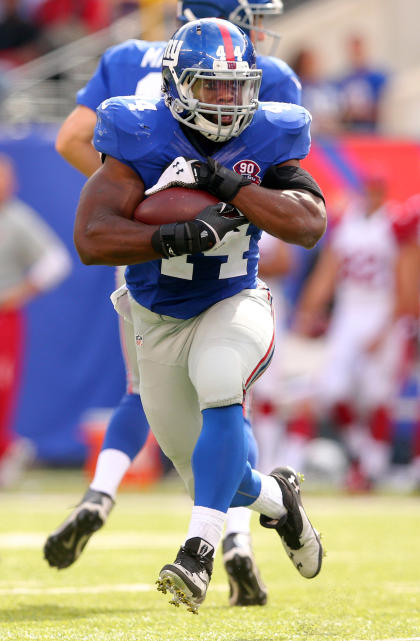Splitsville: Seeing red

Let’s focus this week on a close examination of the area of the field where our fantasy football bread is buttered — the red zone.
A quarter of the season in the book for most teams is enough of a sample to draw reasonably firm conclusions on play-calling tendencies in this most important area of the field. Our preference, of course, depends on our portfolios. We want the teams our receivers are on to pass in the red zone, especially if we drafted properly and have ideal red zone targets who are big and tall. But if we are lucky enough to have the increasingly rare running back who carries on early downs and in short yardage, we of course want our teams to be run dominant in the red zone.
Thanks to the great Pro-Football-Reference for the data.
Currently we have eight teams who have been pass dominant inside the opponent’s 20, meaning they throw the ball over 60% of red zone snaps. They are in order: Chicago 74%, Green Bay 70%, Denver 68%, Oakland 65%, Dallas 63%, Pittsburgh 63%, Indianapolis 61%, Arizona 61%.
Here are the run dominant teams, meaning they run over 60% of red zone snaps. These are the most friendly scoring environments for backs once the team gets in the red zone. More on those rates later. Run-oriented red zone offenses are Cincinnati 67%, Seattle 65%, Carolina 63%, San Francisco 62.5%, Minnesota 62%, Washington 61%.
I’m going to let you connect the dots yourself with relevant players who are most impacted by these red-zone play-calling splits.
How about simply getting into the red zone, the number of possessions per game being the most important stat? That’s the bigger worry aside from play-calling. For example, who cares about the Raiders preferences in the red zone if they are rarely there?
I ignore red zone efficiency because it’s random. Note, however, that teams that run the best in the red zone tend to be be more efficient there. But that’s probably the hardest thing for an offense to do.
Most red zone possessions per game: Giants 5, Indianapolis 5, Miami 4.5, Cleveland 4.3, Baltimore 4.2, New Orleans 4.0.
The teams with the fewest red zone possessions per game are Jacksonville 1.2, Oakland 1.5, Atlanta 2.2, Detroit 2.5, Tennessee 2.5, Houston 2.5, Carolina 2.5, St. Louis 2.7, New England 2.8, Minnesota 2.8.
I wouldn’t worry about this with the Falcons, who have had long scoring plays that obviously take away possessions that could end in the red zone while still producing touchdowns. We need to always apply common sense to the data. Ditto Detroit.
Looking further, the Giants have run the ball 11 times inside the opponents’ three-yard line and have just four TDs, which is terrible. Expect more Andre Williams on the goal line. Other noteworthy trivia near the goal line is that Philadelphia and Pittsburgh each have one running play inside the three, a fact further limiting the struggling LeSean McCoy’s value and preventing Le’Veon Bell from ascending to the highest fantasy football heights. Their teams only have three and zero pass plays there, respectively. These opportunities in close are random — pass interference calls, guys getting tackled inside the five after moving the chains, these are tough things to predict.
Andrew Luck is making a living on the goal line, with five TD passes from inside the three. Last year only one team had more than six for the entire season, Denver (12). These easy short TDs are a fluke that’s boosting Luck’s value. He’s still valuable without them, of course. Especially when he’s playing opponents in the putrid AFC South.
Let’s look at the players who often benefit the most in close, the tight ends.
I’m tired of coaches randomly telling us what they think players can or can’t do. Why is Travis Kelce still not getting all the snaps at tight end for the Chiefs? The two things we want a tight end to do are catch and block. Is Kelce a bad blocker or at least a worse blocker than the Chiefs tight end getting twice as many snaps as him for the season, Anthony Fasano?
I grade pass catching by ranking each tight end with at least 10 targets in yards per target. That’s simply receiving yards divided by targets. For blocking, I consulted ProFootballFocus and used their run blocking rankings. I’m not concerned about pass blocking for tight ends because those who can catch should be in patterns on passing downs, not blocking.
So we add the yards per target ranking and the run blocking ranking to get an overall, all-encompassing ranking. Guys who are tops this way should be getting major snaps or at least should not be out-snapped badly by teammates at the same position.
Here’s the top 10 in order: Delanie Walker and Kelce are tied at number one and have 187 and 133 snaps, respectively. Already we have a problem because Fasano again has 264. Why? Kelce is the third-best blocking tight end according to ProFootballFocus and Fasano is 13th; Kelce is third in yards per target while Fasano is 20th.
But Kelce isn’t even the most screwed tight end with snaps. Jets rookie Jace Amaro is the third-ranked tight end (8th in yards per target and sixth in run blocking), out of 34, yet has 92 snaps. Teammate Jeff Cumberland has 241 and ranks 29th of 34 and 32nd in run blocking (he’s 21st in yards per target). The other top multidimensional tight ends are Dwayne Allen, Jimmy Graham, Julius Thomas, Larry Donnell, Martellus Bennett, Zach Ertz and Jason Witten. The worst tight ends, worst first: Brent Celek, Levine Toilolo, Mychal Rivera, Cumberland, Brandon Myers, Coby Fleener and Heath Miller.

 Yahoo Sports
Yahoo Sports 
